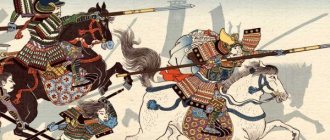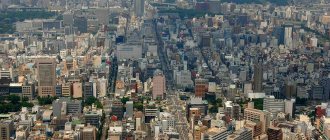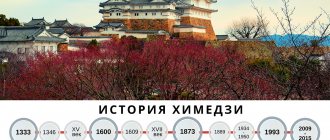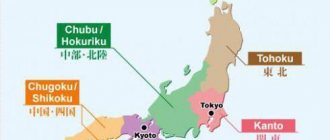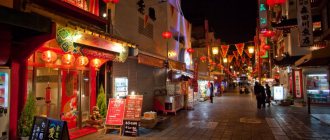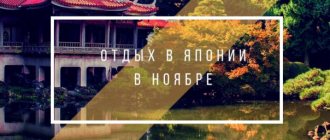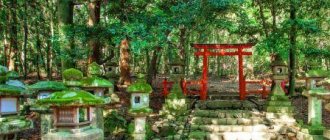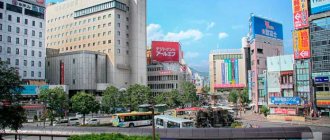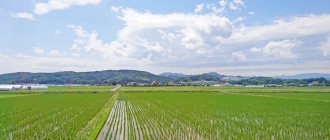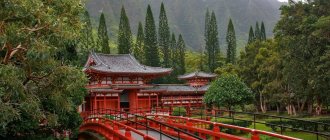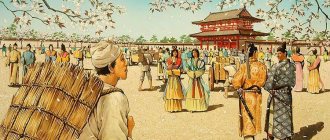Amazing and mysterious Japan, located on islands between the Pacific Ocean and the Sea of Japan, is a treasure trove of ancient traditions and unique culture. Literally every free plot of land here is used for gardens or city parks. In the Land of the Rising Sun, historical monuments, ancient temples and natural heritage are carefully preserved and honored. Japan is not only a land with a unique ancient culture, but also a state of great opportunities. Technical innovations and developments constantly appear here and become world famous.
Ocular Bridge over the Nagashima River in Nagasaki
The products of Japanese manufacturers are used by millions of people on Earth. Japan is one of the most highly developed countries in the world, but this does not prevent its inhabitants from preserving their culture and passing it on from generation to generation. In addition, everyone can get in touch with Japanese culture, plunge into the very essence of the Japanese national flavor, for example, by dressing up in a traditional kimono or attending a tea ceremony, taking a couple of lessons from a professional geisha or contemplating a sumo fight.
Information for tourists:
Route: Tokyo - Fujiyama - Kyoto - Hiroshima - Fukuoka - Nagasaki.
Route on Yandex.maps
Distance: 1434 km.
Estimated time: 10–16 days.
The best time to travel: mid-March - early May (cherry blossom period) and September - October.
Visa: citizens of Russia and CIS countries need a national visa to visit Japan, which can be obtained at the Consular Section of the Japanese Embassy in Moscow, as well as at the Consulates General located in St. Petersburg, Vladivostok, Khabarovsk and Yuzhno-Sakhalinsk. The Japanese national visa is one of the most difficult to obtain.
How to get there: daily direct flights from Moscow to Tokyo are operated by air, and the Japanese airline JAL flies on this route three times a week. Travel time is about 10 hours. In addition, direct flights from Khabarovsk and Vladivostok are operated by air carrier S7. There are also many options for connecting flights in major cities in Europe and Asia. Ticket price - from $500.
Tokyo
Modern Tokyo is a huge, dynamic and high-tech metropolis, in which life is constantly in full swing. Its streets are always filled with crowds of hurrying people. The most striking example of this is the Shibuya intersection, considered the busiest in the world. Once here, you understand that Tokyo is a big anthill that lives by its own laws. One of the main symbols of the Japanese capital is the Tokyo Television Tower, built in 1958. Its height is 333 m. Due to its external similarity, this tower is often compared to the Eiffel Tower. The ultra-modern Three Towers skyscrapers on Harumi Island and the Yoyosh Olympic complex will make an indelible impression.
Panorama of Tokyo. Tokyo Bay and Rainbow Bridge
Tokyo is so huge that it has several national parks, among which Ueno Park is worth highlighting. On its territory there is a huge number of museums, as well as the oldest zoo in Japan.
There are so many museums in Tokyo that it is difficult to name their exact number. Of those that deserve the most attention, it is worth noting the Tokyo National Museum, the Edo-Tokyo History Museum, the Shitamashi Historical Museum (the most colorful), the Miraikan National Museum for the Development of Science and Innovation, and the Kite Museum (more than 4 thousand exhibits). The Japanese capital has many museums with highly focused exhibitions, the likes of which are virtually unparalleled. For example, museums of ballpoint pens, glasses, lighters, bicycles, etc. In the Japanese capital, three troupes of the National Theater of Japan are represented - kabuki, but also bunraku. There are a huge number of attractions in Tokyo, but perhaps the most touching and significant is the bronze monument to the dog named Hachiko. He is known as the most loyal dog in the world because he came to Shibuya Station for nine years waiting for his deceased owner.
Shibuya Crossing is one of the busiest pedestrian crossings in the world
Kokyo Imperial Palace in Tokyo
Day 9. Flight to Tokyo
To return to Tokyo in time for your return to Moscow, we suggest flying directly to your departure airport. Find a convenient flight on OneTwoTrip.
Expert advice
- To plan your travel within and between cities, use the Rome2Rio service.
- Use offline maps Citywalks.me and Maps.me.
- To avoid getting confused in the huge number of Tokyo metro stations, download the navigator app.
- If you plan to travel by train frequently, it is beneficial to purchase a Japan Rail Pass, a travel pass for foreigners that can be purchased for 1, 2 or 3 weeks. Detailed information about the pass can be found on the Japan-guide website.
- In Japan it is not customary to tip. Trying to tip may be considered an insult.
Fuji
Fuji is a sacred mountain for the Japanese. Every resident of the Land of the Rising Sun considers it his duty to climb to its peak at least once in his life. Mount Fuji is a dormant volcano on the island of Honshu, which, according to chronicles, last erupted at the beginning of the 18th century. The diameter of its crater is about half a kilometer, and the depth barely reaches 200 m. The ancients believed that the souls of the dead lived in the depths of the volcano. At the top of the mountain there is a Shinto shrine and a weather station. Fuji and the adjacent area called “Five Lakes of Fuji” are part of the Fuji-Hakone-Izu National Park.
The sacred Mount Fuji is reflected in the clear waters of Lake Shoji, which lies at its foot.
Only two months a year - in July and August - four routes are open to everyone, allowing them to climb to the top of the sacred mountain. During the rest of the year, climbing attempts are considered extremely dangerous and are officially prohibited. The ascent takes from 5 to 8 hours and must be accompanied by a professional instructor.
Fuji is the most revered mountain in Japan. In good weather, its peak is visible from Tokyo
How to organize your own trip
Japan is a real mystery that is interesting to unravel slowly, step by step exploring all the sights, choosing new destinations for tourists to go to. Choosing suitable cities where to go to Japan in the fall or spring will be interesting (and sometimes instructive) even for those who have not previously visited this country. A trip abroad for the first time can be timed to get acquainted with the most famous sights of the region.
We recommend starting your trip from Tokyo and going to Kyoto. You can exchange noisy megacities for a day by staying in small villages. This is the best place to get acquainted with the unchanging traditions of the local population. It is important to take time to visit temples and monasteries. The atmosphere in such places is inspiring, and the monks are happy to give you a tour. A big advantage of traveling to Japan is that many people here speak English and there are signs.
Kyoto
Kyoto from its founding until the middle of the 19th century. was the capital of Japan. Later, Tokyo began to perform this function, and Kyoto received the title of the main cultural center of the country. This city is a real treasury, which contains 2 thousand monuments, Buddhist monasteries and amazing parks. The traditions of Japanese gardeners, which originated in Kyoto, had a huge influence on the development of landscape design throughout the world.
The famous 4 km tunnel of 10,000 torii at Kyoto's Fushimi Inari Shrine
One of the main attractions of Kyoto is the Gosho Imperial Palace. Despite the name, the Emperor of Japan does not live here these days: his residence is located in Tokyo. Organized tours are held throughout the halls of the palace. Not far from Gosho is Nijo Castle, built in 1603 as the residence of the shoguns. The dominant feature of the castle complex is the Ninomaru Palace, equipped with the most modern, by the standards of the Middle Ages, security system - “singing floors”. If you step on such a floor, it will immediately begin to make a sound and attract attention.
The symbol of Kyoto - the Golden Pavilion - must be looked for on the shore of the lake in the Kita area. It was originally the holiday villa of Shogun Ashikaga Yoshimitsu, and after the death of the owner, it was turned into a Zen temple. In 1950, it was burned down by vandals. The current building is an exact copy, restored in 1955. Its walls, like many centuries ago, are covered on the outside with sheets of gold leaf. The two-tier Silver Pavilion, also built under Ashikaga Yoshimitsu, looks no less fascinating, but, unlike its brother, it is not covered with precious metal. Among the most luxurious temples in Kyoto, one should also highlight the Shinto complex of Fushimi Inari, founded in the 8th century. A 4-kilometer torii tunnel leads to the temple - a red ritual gate without doors.
Heian Jingu is a Shinto shrine in Kyoto, built in 1895 to commemorate the 1100th anniversary of the founding of the city.
Foxes are messengers of the god Inari
Japan
© wikimedia.org
Japan is divided into 47 administrative divisions (prefectures): the capital "to" (都) prefecture is Tokyo; governorate "do" (道) - Hokkaido; two “fu” (府) cities with prefectural status—Kyoto and Osaka; 43 "ken" (県) prefectures. Prefectures, in turn, are divided into smaller administrative units: counties, 14 districts of Hokkaido, 17 special cities (whose population exceeds 500,000 people). The capital Tokyo is not considered a special city, however, like a city in general, being an urban conglomerate.
It is also necessary to mention the still unresolved dispute between Japan and Russia regarding the ownership of the southern Kuril Islands (Iturup, Kunashir, Shikotan islands and the Habomai group of islands), which came under the control of the USSR in the last days of World War II, and included in the Khabarovsk Territory since 1946 RSFSR together with the other Kuril Islands and Southern Sakhalin (now the Kuril and Yuzhno-Kuril urban districts of the Sakhalin region). In addition, Japan disputes the ownership of the Liancourt Islands by South Korea. In turn, the ownership of the Senkaku Islands, controlled by Japan, is disputed by China and Taiwan.
Japan's prefectures are conventionally grouped into regions, "quiet" (地方). They have developed historically, but are not administrative units.
Below is a list of "quiet"
Hokkaido
Hokkaido (北海道 Hokkaido, "North Sea Governorate") is the northernmost prefecture of Japan, located on the island of the same name, Japan's second largest island, and smaller nearby islands, consisting of 14 districts. The Seikan railway tunnel is built under the Tsugaru Strait, separating Hokkaido from Honshu.
The administrative center of the governorate and the largest city of Hokkaido is Sapporo. The major cities are Hakodate (in the south) and Asahikawa (in the center), as well as the ports of Tomakomai, Muroran and Otaru. The region is famous for its forests, marine fishing (especially salmon fishing) and seafood.
Sapporo
Sapporo is the fourth largest city in Japan, an important economic, industrial and cultural center of the country. Sapporo is also a resort famous for its thermal waters. Tourists in Sapporo are also attracted by the sights: the symbol of the city, the Clock Tower; Odori Park; the Ishiya chocolate factory, which produces the famous Shiroi KoiBito white chocolate; Beer Museum; traditional pioneer village of Hokkaido (museum of the history of the island from the early 20th century); Modern Art Museum; Art Park; Botanical Garden. Many visitors also flock to Sapporo to take part in the famous annual Snow Festival.
In the world, Sapporo is best known as the capital of the 1972 Winter Olympics and three Asian Winter Games in 1986, 1990 and 2017.
Tohoku
Maneki-neko
Tohoku or Ou (東北地方, "northeast region") is "quiet" in the northeast of the island of Honshu. The center of the region, consisting of 6 prefectures, is Miyagi Prefecture. The largest cities are Sendai, Fukushima, Aomori.
The region is famous for its agricultural industry, mining of coal, gas, oil and other minerals. From the west it is “quietly” washed by the Sea of Japan, from the east by the Pacific Ocean. The area is hilly or mountainous and covered with forests. Tourism plays a major role in the region's economy. Attractions include Lake Towada, Matsushima Bay and Bandai-Asahi National Park.
Fukushima
Fukushima (福島市, “island of happiness”) is a city located in the northeast of the island of Honshu, the administrative center of the prefecture of the same name. The first settlement on the site of present-day Fukushima was called Shinobu-no-sato (“Shinobu Village”). In the 12th century, a castle was built there, unfortunately, it has not survived to this day, around which the city grew. During the Edo era, Fukushima was famous for silk weaving, and after the Meiji Restoration it became the administrative center of the prefecture.
Fukushima gained sad worldwide fame on March 11, 2011, when a major radiation accident occurred at the Fukushima-1 nuclear power plant, which occurred as a result of the strongest earthquake in the history of Japan and the subsequent tsunami.
Kanto
Kanto (関東地方 "region east of the outpost") is a "quiet" region on the island of Honshu, the most highly developed part of Japan. The capital of Tokyo, the residence of the emperor and the government of Japan is located here. The region unites 7 prefectures. Tokyo and Yokohama form a single industrial complex stretching along the coast of Tokyo Bay. The most developed industries here are the electrical and electronics industry. Chicho is also known for its raw silk, grown in the Kanto plain and western mountain valleys.
Besides the Tokyo metropolitan area and the city of Yokohama, other major cities are Kawasaki, Saitama and Chiba.
Tokyo
Tokyo (東京, “eastern capital”) is the capital of Japan, its administrative, financial, political center, as well as the cultural heart of the country. The city is located in the southeastern part of the island of Honshu in the bay of Tokyo Bay in the Pacific Ocean. Greater Tokyo is an administrative division of Japan consisting of special districts of Tokyo, the Tama region and the Island Territories (Izu and Ogasawara islands).
Tokyo is also a center of attraction for tourists from all over the world, because it amazingly combines the futuristic landscape of a modern metropolis, historical attractions and cultural entertainment. In Tokyo there is the Imperial Palace and a huge number of temples, parks and gardens, authentic restaurants, shops for every taste.
Yokohama
Yokohama
Yokohama or Yokohama (横浜市) is the largest port city in Japan, located on the western shore of Tokyo Bay, 30 km from Tokyo, and is the administrative center of Kanagawa Prefecture. The city was founded in 1858 on the site of the already existing small fishing villages of Yokohama and Kanagawa. Then construction began on a port that received the first foreign ships, which contributed to the economic development of Yokohama.
Tourists are attracted to Yokohama by the sights: the tallest skyscraper in the country, Landmark (300 m), which has become a symbol of the city; openwork suspension bridge across Yokohama Bay (1989) 860 m long; Yamashita Park; park "Minato-no-Mieru-oka-koen"; open air museum "Sankeien"; Ramen Museum (1994) - a noodle museum occupying a multi-story building; marine with the largest aquarium in Japan on an artificial island; amusement parks Joypolis and Yokohama Dreamland.
Tube
Chubu (中部地方, "central region") is a "quiet" region in central Japan on the island of Honshu. There are 9 prefectures in the region, the central one being Aichi Prefecture. Large cities are Nagoya, Shizuoka, Niigata.
Nagoya
Nagoya (名古屋市 "family old house") is the fourth most populous city in Japan, located in the central part of the island of Honshu. Nagoya is one of the largest ports in Japan, an important commercial and industrial center of the country and the administrative center of Aichi Prefecture. Due to its location between the ancient capital of Kyoto to the west and the modern capital of Tokyo to the east, Nagoya was called Chūkyō (中京, "middle capital").
People began to settle in Nagoya at the beginning of the 1st century. In the 17th century, there were several settlements here, the largest of which was Atsuta, which arose at the Shinto shrine of the same name. In 1610, shogun Tokugawa Ieyasu built Nagoya Castle, around which the city soon grew. In the first half of the 20th century, Nagoya became a major commercial and industrial center of Japan, which it still is today. The city was heavily damaged by bombing during World War II, but was rebuilt after its end.
Tourists to Nagoya are attracted by interesting sights: Nagoya Castle - the symbol of the city; the Atsuta Temple, which houses the Kusanagi no Mitsurugi - the sacred sword, one of the three symbols of the emperor; Meiji-mura Park - an open-air museum; Urakuen Park with the preserved tea house of the founder of the classical school of tea drinking, Uraku-ryu; Monkey Park; museum at the Toyota Motors factory.
Kansai
Kansai (関西地方, "region west of the outpost") is a "quiet" region in western Japan on the island of Honshu, also called Kinki (近畿地方) - "metropolitan region". There are seven prefectures in the region, with Kyoto Prefecture being the central one. The largest cities are Osaka, Kobe, Kyoto.
Osaka
Osaka
Osaka (大阪市) is the third most populous city in Japan, the center of the prefecture of the same name, located in the southern part of the island of Honshu, on the eastern coast of Osaka Bay in the Inland Sea of Japan. Osaka is cut by rivers and canals, for which it has received the name “Japanese Venice”.
Osaka is the historical trading capital of Japan, and is now an important industrial center and one of the country's largest ports. The original settlement on the site of Osaka, which arose no later than the 4th century, was called Naniwa; it was the very first capital of Japan until the Nara period.
Osaka offers tourists many interesting attractions: the five-story samurai Osaka Castle (a copy restored after the end of World War II); Osakajo-Koen Park; Sumiyoshi Temple; the ancient Buddhist temple of Shitennoji; theme park Universal Studios Japan.
Kyoto
Kyoto (京都市) is a city located in the central part of the island of Honshu, in the southwestern part of Kyoto Prefecture, of which it is the administrative center.
From 794 to 1869, Kyoto was the capital of Japan and the main residence of the emperors. The city was originally called Heian. During World War II, when Japan was bombed by the Allies, Kyoto was not damaged at all. 1,600 Buddhist and 400 Shinto temples, gardens, parks and palaces survived. In this context, it is worth mentioning a little-known fact, information about which was preserved by Japanese Shinto scholars: Kyoto was saved from air strikes only because the Russian Japanese scholar Professor Sergei Eliseev (son of the owner of famous stores), who lived and worked in the USA, wrote a letter General MacArthur, in which he asked to spare Kyoto.
Today, Kyoto is Japan's main cultural center and one of Japan's most popular tourist destinations. Among Kyoto's most famous temples are the unique wooden hillside temple of Kiyomizu-dera; Kinkaku-ji (“Golden Pavilion” or “Golden Temple”); Ginkaku-ji ("Silver Pavilion"); Ryoan-ji rock garden; Heian Jingu Shinto Shrine, built in 1895 to commemorate the 1100th anniversary of the founding of the city. Famous parks include Maruyama Park, the Botanical Garden and the park at the former Imperial Palace.
Kyoto is also home to one of the most famous geisha quarters in Japan - hanamachi. In addition, Kyoto is the birthplace of Haruki Murakami, a world famous writer.
Nara
Nara (奈良市) is a city in central Japan, the administrative center of Nara Prefecture, famous for its ancient history. Nara was the capital of Japan during the Nara period 710 - 784 and was called Heijo (“capital of the citadel of the world”). The city was built on the model of the Chinese capital Chang'an (Tang period). Since those times, the city has preserved many temples and sanctuaries, including the Kofukuji Buddhist Temple with three-tier and five-tier pagodas; To-Kondo Temple with prayer hall and pagoda; Todaiji temple complex with the Big Buddha Hall - the world's largest wooden building and a large bronze statue of Buddha seated on the petals of a sacred lotus. Nara is also famous for its magnificent parks, which are home to tame deer.
Kobe
Kobe (神戸市) is the sixth largest city in Japan, the capital of Hyogo Prefecture, located on the island of Honshu. Since the 8th century, Kobe has been known as one of Japan's most important ports and a center of international trade.
Historically, the city was a center for the production of Japanese rice wine sake, home to the Yakuza mafia group and a significant religious center. From the middle of the 19th century, Kobe began to develop industry and the production of artificial pearls. Kobe was heavily damaged in the 1995 earthquake but quickly recovered.
The sights of Kobe are: an art museum; Shinto shrines Ikuta, Nagata and Minatozawa, Suma Temple, Sorakuen Park, old European quarters of Yamamoto Street, aquarium, port tower. Among the architectural structures of our time are the Hyperboloid Grid Tower in the port of Kobe (1968) and the longest suspension bridge in the world, Akashi-Kaikyo, connecting the city with Awaji Island.
Chugoku
Kyoto. Golden Temple
Chugoku (中国地方, "region of the middle lands") is a "quiet" located in the west of the island of Honshu, in the mountainous area north and south of the Chugoku Range (1713 m). The region's name comes from its location between the ancient capital of Kyoto and the island of Kyushu. Chugoku is an industrial-agrarian region, its center is Hiroshima Prefecture, the capital of the same name, the city of Hiroshima, is the largest populated area in the region. Other large cities are Okayama, Yamaguchi.
Hiroshima
Hiroshima (広島市, "broad island") is the largest city in the Chugoku region, located in the southwest of Honshu Island, the capital of Hiroshima Prefecture.
Hiroshima was founded at the end of the 16th century by the Mori samurai family. The city developed economically actively in the period 1894–1895. In 1945, it became the first populated area in history to suffer a nuclear bomb. After the end of World War II, on August 6, 1949, the Japanese authorities proclaimed Hiroshima a “city of peace,” and the city began to actively rebuild. In the area of the epicenter of the explosion, a Peace Memorial Park with an area of more than 12 hectares was created. By the early 1960s, Hiroshima had been almost completely rebuilt.
Major tourist attractions include the Peace Memorial Park (listed as a UNESCO World Heritage Site) with the Peace Museum and Cathedral; Genbaku dome; Rijo Castle; Buddhist temples of Mitaka and Fudoin; Botanical Garden; Asa Zoo; Japanese garden Shukkeien; museum at .
Shikoku
Shikoku (四国, "four regions") is the smallest island in terms of area and population of the four main Japanese islands, and also the eponymous "chiho" of Japan. The name "four regions" was formed in ancient times, when the island was divided into four historical regions - Awa, Iyo, Sanuki and Tosa. The region consists of four prefectures, the largest city is Matsuyama, the capital of Ehime Province.
Matsuyama
Matsuyama (松山市) is the capital of Ehime Prefecture on Shikoku Island. Matsuyama is a university city and also a city of poets. A native of the city, Masaoka Shiki became famous thanks to his reform of haiku, in honor of which the city annually hosts a competition of haiku poets. Every year, 3,000 poets create 50,000 haiku, from which the most worthy poems are selected. Also in Matsuyama, every two months there is a local competition for the best haiku, in which anyone can take part.
In addition, tourists are attracted to the city by attractions: Matsuyama Castle with the historical Ninomaru Garden; Buddhist temple Ishite-ji; Municipal Museum "Matsuyama Shiki Kinen", dedicated to Masaoka Shiki and haiku.
Kyushu and Okinawa
Dojo-ji Temple
Kashu and Okinawa are the “quiet” of Japan, occupying the islands of Kyushu and Okinawa.
Kyushu
Kyushu (九州, "nine provinces") is the third largest island of Japan, washed in the east by the Pacific Ocean, in the northeast by the Inland Sea of Japan, and in the west by the East China Sea. Administratively, Kyushu is divided into 7 prefectures, the largest city is Fukuoka, the center of the prefecture of the same name.
Okinawa
Okinawa (沖縄本島) is the largest island of the Ryukyu archipelago, located between the island of Kyushu and Taiwan, the prefecture of the same name. The main city is Naha. Okinawa is known throughout the world as the birthplace of the martial art Okinawa-te, the foundations of which laid the foundation for most styles of karate.
Long a Chinese dependency, Okinawa (formerly the Ryukyu Kingdom) was conquered by the Japanese in 1879. In April - June 1945, during the Battle of Okinawa, the city was captured by American troops. The Battle of Okinawa was one of the bloodiest battles in the history of World War II, killing 200 thousand people on the Japanese side alone. An American military base was created on the island, which is a key strategic facility and controls all approaches to Japan, which existed until 1972. The island is still home to a powerful network of American military bases.
Fukuoka
Fukuoka (福岡市, "lucky hill") is a major port in southwestern Japan; the administrative center of Fukuoka Prefecture, and one of the ten largest cities in Japan. The city is considered an important political, cultural and economic center of the country. In the 7th century, Fukuoka was known as Hakata, a port with successful trade with Korea and China, located on the eastern bank of the Nakagawa River.
At the beginning of the 17th century, a castle was built on the banks of the Nakagawa River. Today's city of Fukuoka is the result of the merger in 1889 of two cities - the port of Hakata and the city that arose around the castle, which has reached us only in the form of ruins. It is these ruins, as well as Higashi Koen Park with the Nichiren monument, that are the main local attractions.
Hiroshima
Hiroshima is a medieval samurai city on the island of Honshu, founded at the end of the 16th century. It became famous after the nuclear bombing by the US Armed Forces in 1945. A powerful atomic bomb was dropped on the city, after the explosion of which about 12 km2 of territory was affected. Today this area is occupied by the Peace Memorial Park. Within its boundaries are the Peace Memorial Museum, the Peace Memorial Cathedral, various monuments and a ritual bell, as well as the Peace Flame lit on August 1, 1964. One of the main monuments of the park is the monument to the children of the world.
The Genbaku Dome is a memorial to the victims of the bombing of Hiroshima in 1945.
On a bronze pedestal there is a sculpture of the girl Sadako Sasaki, who fell ill with leukemia as a result of the atomic attack. One day, her best friend brought to the hospital a figurine of a crane, folded from a piece of paper, and told her that in order to fulfill her cherished desire, she needed to make a thousand such birds. The girl began folding origami, but managed to make only 644 cranes before she died. Opposite the park stands the main witness to the terrible events of the past - the Genbaku dome. This is the only building in Hiroshima whose walls survived the explosion and remain to this day.
In addition to the monuments associated with the tragic events, some ancient monuments have been partially preserved and reconstructed in Hiroshima. The main one is Hiroshima Castle, or Carp Castle. This is one of the most beautiful buildings in Japan. It was built by the ruler Mori Terumoto in 1589. Today, within the walls of the wooden fortress you can visit an exhibition dedicated to the history of the castle, the life of the samurai and the culture of Japan. Also on the castle grounds is the Shinto shrine of Gokoku-jinja, destroyed during the war and rebuilt.
Torii gate on Miyajima Island in Hiroshima
In addition, Hiroshima has many museums whose exhibitions are not related to the war. This is the Museum of Transport with cars of the past, present and future, the Children's Museum, which tells about the exact sciences in an accessible form, the Museum of Art, demonstrating the works of Japanese artists, etc.
Carp Castle
Food and restaurants: how much do they cost?
Traditional food on the island is very different from the usual dishes, for example, that can be found in Italian or Belgian cuisine. There is a rich and varied food here for every taste - from the familiar sushi to onigiri and takoyaki (rice or octopus balls). We recommend trying fried eel, marbled beef, omurice (a special omelette), and mochi for dessert.
Food prices in Japan are fair; if you wish, you can choose a place for lunch to suit any budget: restaurants and cafes, street eateries, and buy ready-made food (bento) in supermarkets. If you are used to high service and beautiful presentation of dishes, go to large restaurants, if you want to get to know local delicacies better, do not hesitate to visit small cozy establishments.
Fukuoka
Fukuoka is the largest city on the Japanese island of Kyushu. It arose around a castle built by the feudal lord Kuroda Nagamasa. Today, only ruins remain of the fortification. Despite numerous bombings during World War II, some Shinto shrines remain in Fukuoka. The most famous and most ancient temple, Sofukuji Temple, is located next to the main city station. It is called the birthplace of the Japanese tea ceremony. The Fukuoka City Museum is known throughout Japan for its main exhibit, the country's national treasure - a gold seal dating back to the 1st century. And at the Fukuoka Art Museum you can look at the “Madonna” by Salvador Dali, purchased for $5 million. The city is famous for its picturesque parks. The most comfortable and conducive to leisurely walks are Ohori Park and Momochi Coastal Park with a 234-meter tower with an observation deck at the top. Modern leisure options in Fukuoka are offered by the Canal City Hakata shopping and entertainment complex, consisting of almost 300 shops, restaurants, a cinema theater and several hotels. And this urban miracle is decorated with an amazing artificial canal.
Japanese garden in Fukuoka
The city of Dazaifu is a 40-minute drive from Fukuoka. In the period from the 7th to the 11th centuries. This is where the Kyushu government building was located. Today, all that remains of it are the foundation stones, around which there is a beautiful park with blooming lotuses and a rock garden. There is also an exhibition complex telling about the history of the city.
Pagoda at Ohari Park in Fukuoka City

